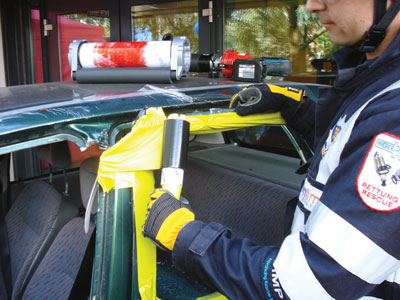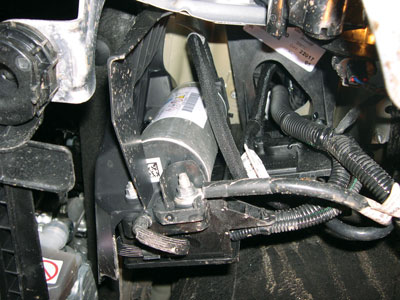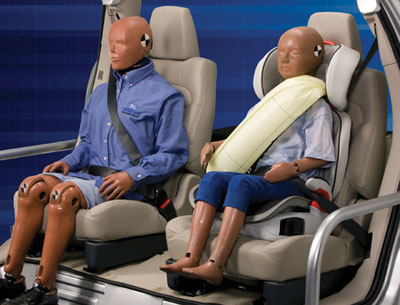
Auto-ex Update
Randy Schmitz
Features Extrication TrainingInnovations in the car industry continuously create new challenges for rescuers.
Innovations in the car industry continuously create new challenges for rescuers. Fortunately, products are coming to market that tackle some of the hurdles first responders encounter when responding to vehicle collisions.
Packexe film strong enough for sharps wrap
In the August 2011 issue of Fire Fighting in Canada, I wrote about a great new innovation from Packexe, the company that developed a protective film to capture window glass prior to its breaking and removal. Packexe has developed another interesting application.
 |
|
| (Photo 1) A firefighter uses Packexe’s sharps wrap to cover exposed areas after they’ve been cut with hydraulic tools. Photos by Randy Schmitz
|
This time, the plastic wrap and mini applicator is thicker, enabling the material to cover up sharp metal after it has been cut or breached with hydraulic and power tools. For example, when the roof is cut off and there are sharp metal pillars exposed, you can protect yourself and your victim by covering the pillars with sharps wrap, as in photo 1. You can also add a small floor mat around the pillar end and use the sharps wrap to cover it up and hold it in place. The product should be available this fall. For more information, visit www.packexe.co.uk/smash.
Manoeuvring around start/stop systems
A new trend has emerged in the auto industry, known as start/stop systems. These systems allow a vehicle to shut down when not in motion – at a stoplight, for instance – thus increasing fuel economy and reducing the carbon footprint. However, the draw on the electrical system within the vehicle can be quite high when immediately re-engaging the engine.
 |
|
| (Photo 2) The ultracapacitor, usually located either in the left front wheel well or in the left front fender, contains a chemical called acetonitrile, which is highly flammable and harmful if ingested or inhaled.
|
To overcome this obstacle, manufacturers can offer two different power sources: a smaller auxiliary battery to handle the extra energy demand placed on the system, which still allows electrical components such as the stereo and GPS to operate unaffected; or an ultracapacitor, which is simply a high-energy storage source.
The auxiliary battery concept has been around for a while in higher-end models (for example, 2009 to 2012 Mercedes Benz C Class and the Mazda 3), and can be dealt with in a rescue situation by simply disconnecting the positive and negative cables (along with the main 12-volt battery cables).
The ultracapacitor, on the other hand, has some uncharted potential issues that may affect rescuer safety. Even though the ultracapacitor can store large amounts of energy, it is functional only with 5.2 volts, so it is not an electrical hazard by any stretch. However, the ultracapacitor contains a chemical called acetonitrile, which is highly flammable and harmful if inhaled, ingested or in contact with skin (check your material safety data sheet for more information). Inadvertently breaching the unit with hydraulic tools could release the solvent product, which could become a hazard. Damage from a collision can also release the chemical. The unit is generally housed in the left front wheel well or in the left front fender.
Manufacturers of these ultracapacitors and the vehicles that are using them advise rescue personnel to wear full PPE and possibly respiratory protection if a breach is encountered. For fire departments that are working with crash recovery system (CRS) software by Modi-Tech, capacitor location and background information has been added to the software. Currently, these systems are available only in the overseas Peugeot and Citroen models, but many of these vehicles have been imported into Canada, so expect to see more of them. Hybrid buses, which you can find anywhere in North America, are also using the ultracapacitor.
Inflatable seatbelts and centre-seat airbags
Meanwhile, Ford, being on the cutting edge of technology, has developed the first marketed inflatable seat belt for rear-seat passengers, available in its 2012 Ford Explorer line. The seatbelt is designed to deploy only in frontal impacts to minimize the seatbelt pressure in a collision on the upper chest area of small children and older people (see photo 3). The belt is designed to reduce head, neck and chest injuries. A tubular belt bag inflates with cold pressurized gas from a metal cylinder located behind and under the top seatback and the bottom cushion.
 |
|
| (Photo 3) The first marketed inflatable seatbelt for rear-seat passengers is available in Ford’s 2012 Explorer line. |
Gas exits through the cylinder via a diffuser and then moves through a small manifold to the buckle assembly. The airbag deploys out like an accordion, expanding across the occupant’s body. The lower lap strap does not inflate and is the same as a regular seatbelt with the addition of a separate retracting system.
The potential problem for rescuers is the hidden pressurized gas inflator. As mentioned, the cylinder location will not be visible to an unsuspecting rescuer. In the event that the rear seatbacks need to be removed to facilitate an egress path for patient removal, the gas cylinders could be inadvertently cut if using hydraulic cutters to remove the seatback. Thus, rescue teams must expose all seatbacks by cutting the fabric that surrounds the metal framework before using any rescue tools in these areas.
It’s worth noting that not all child seats are compatible with the new Ford inflatable seatbelt system and some carseat manufacturers do not recommend installing their models until further testing has been done. Britiax, for example, is one manufacturer that says its seats are not compatible.
General Motors has just released the centre-seat airbag, designed to minimize occupant collisions within the vehicle during a side-impact collision. The airbag deploys from the right side of the driver’s seat to protect the two front-seat passengers when they are thrown sideways.
The Buick Enclave, the Acadia and the Chevy Traverse will be the first vehicles in the GM line to offer the new technology in 2013.
The airbag will also deploy in a rollover as an added benefit to provide separation between occupants. According to the National Highway Traffic Safety Administration, the implementation of this airbag is expected to reduce the death rate in side impacts with belted passengers by 11 per cent. Again, rescuers need to be aware of these supplemental restraint systems when working inside the vehicle to extricate patients.
Being aware of changes that affect rescuers is paramount to maintaining safety for yourself and your patients.
Stay safe!
Randy Schmitz is a Calgary firefighter who has been extensively involved in the extrication field for 19 years. He is an extrication instructor and has competed internationally. He is the education chair for Transport Emergency Rescue Committee (T.E.R.C.) in Canada, a T.E.R.C. International extrication judge and a tester and evaluator for manufactured prototype products for extrication equipment. He can be reached at rwschmitz@shaw.ca
Print this page